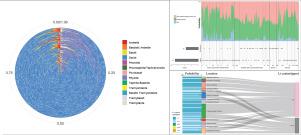Machine learning uncovers provenance of source rocks for volcano-sedimentary lithium mineralization in South China
IF 3.6
2区 地球科学
Q1 GEOLOGY
引用次数: 0
Abstract
The Early to Middle Triassic sedimentary units in South China, belonging to the so-called “Green bean rock” (hereafter “GBR”), host significant volumes of potentially economic clay-type volcano-sedimentary lithium (Li) mineralization. However, the source material and the processes that led to the enrichment of Li in these clay deposits remain unclear. This is especially true of the uncertain provenance of the igneous material that eventually forms this Li mineralization. In this study we apply machine learning to geochemical data from igneous rocks and GBR samples to determine the nature of the source rock, the type and source of the magma associated with the GBR, and the initial Li contents of these protoliths. The results of this Random Forest (RF) modeling indicate that the GBR protolith was entirely derived from a dacitic magma, whereas the petrology of these samples indicate that the source magma for the GBR protolith was derived from an intermediate to acidic dacite-rhyolite magma. The RF modeling suggests the protolith volcanic ash was primarily derived from the Sanjiang Orogenic Belt and the Shiwandashan Belt in South China. The location and distribution of the GBR relative to the Sanjiang Orogenic Belt and the Shiwandashan Belt indicates that the GBR has a significant directionality with preferential NE-SW and N-S orientations, indicating the likely influence of paleomonsoon conditions during GBR formation. The Li content of the GBR protolith is <50 ppm, with 68.75% of the data generated during this study having a Li concentration of <20 ppm, indicating that the Li within the GBR was primarily derived from water–rock interactions during the deposition period. This study provides new insights into the process involved in the formation of the GBR and the associated Li enrichments in this region as well as outlining the value in integrating machine learning models with big data in mineral deposit research.

机器学习揭示华南火山-沉积锂矿化烃源岩物源
华南早-中三叠世沉积单元属于所谓的“绿豆岩”(以下简称“GBR”),具有大量潜在经济效益的粘土型火山-沉积锂成矿作用。然而,导致这些粘土沉积物中Li富集的源物质和过程仍不清楚。对于最终形成这种锂矿化的火成岩物质的来源不确定尤其如此。在本研究中,我们将机器学习应用于火成岩和GBR样品的地球化学数据,以确定烃源岩的性质,与GBR相关的岩浆类型和来源,以及这些原岩的初始Li含量。随机森林(RF)模拟结果表明,GBR原岩完全来源于英安岩岩浆,而岩石学分析表明,GBR原岩的源岩浆来源于中酸性英安岩流纹岩岩浆。RF模拟表明,原岩火山灰主要来自华南三江造山带和十万大山造山带。GBR相对于三江造山带和十万大山造山带的位置和分布表明,GBR具有明显的方向性,倾向于NE-SW和N-S方向,表明GBR形成可能受到古季风条件的影响。GBR原岩的Li含量为50 ppm,其中68.75%的数据Li浓度为20 ppm,表明GBR内的Li主要来源于沉积时期的水岩相互作用。该研究为该地区GBR的形成过程和相关的Li富集提供了新的见解,并概述了将机器学习模型与大数据相结合在矿床研究中的价值。
本文章由计算机程序翻译,如有差异,请以英文原文为准。
求助全文
约1分钟内获得全文
求助全文
来源期刊

Ore Geology Reviews
地学-地质学
CiteScore
6.50
自引率
27.30%
发文量
546
审稿时长
22.9 weeks
期刊介绍:
Ore Geology Reviews aims to familiarize all earth scientists with recent advances in a number of interconnected disciplines related to the study of, and search for, ore deposits. The reviews range from brief to longer contributions, but the journal preferentially publishes manuscripts that fill the niche between the commonly shorter journal articles and the comprehensive book coverages, and thus has a special appeal to many authors and readers.
 求助内容:
求助内容: 应助结果提醒方式:
应助结果提醒方式:


